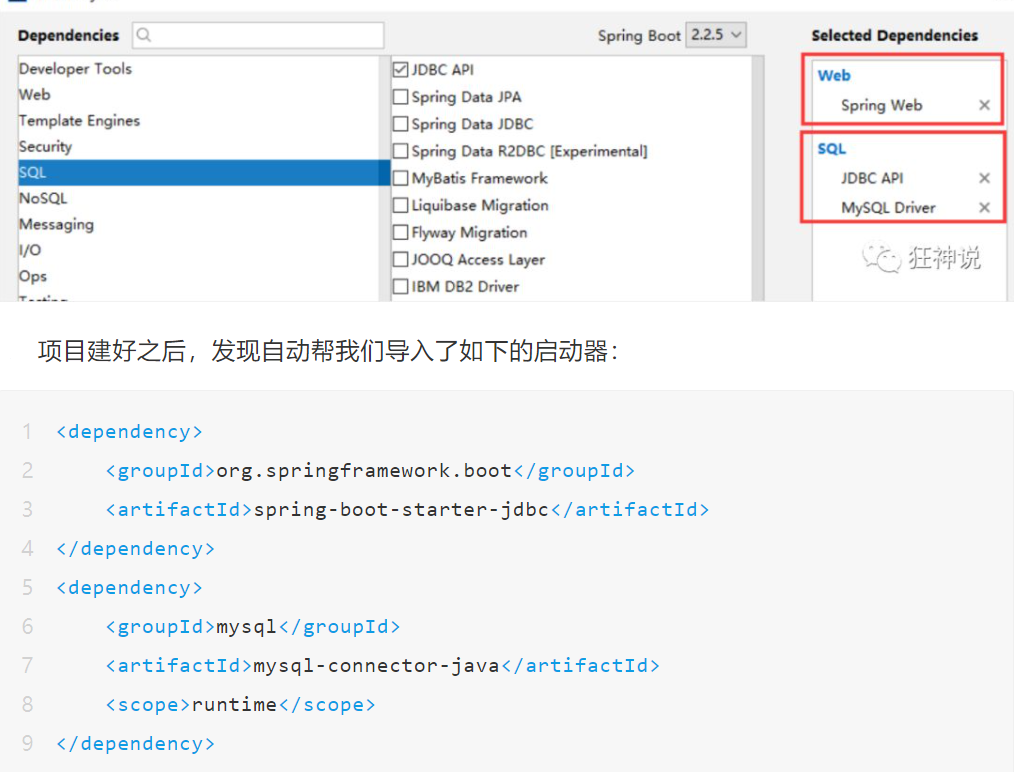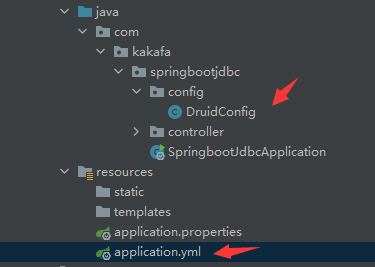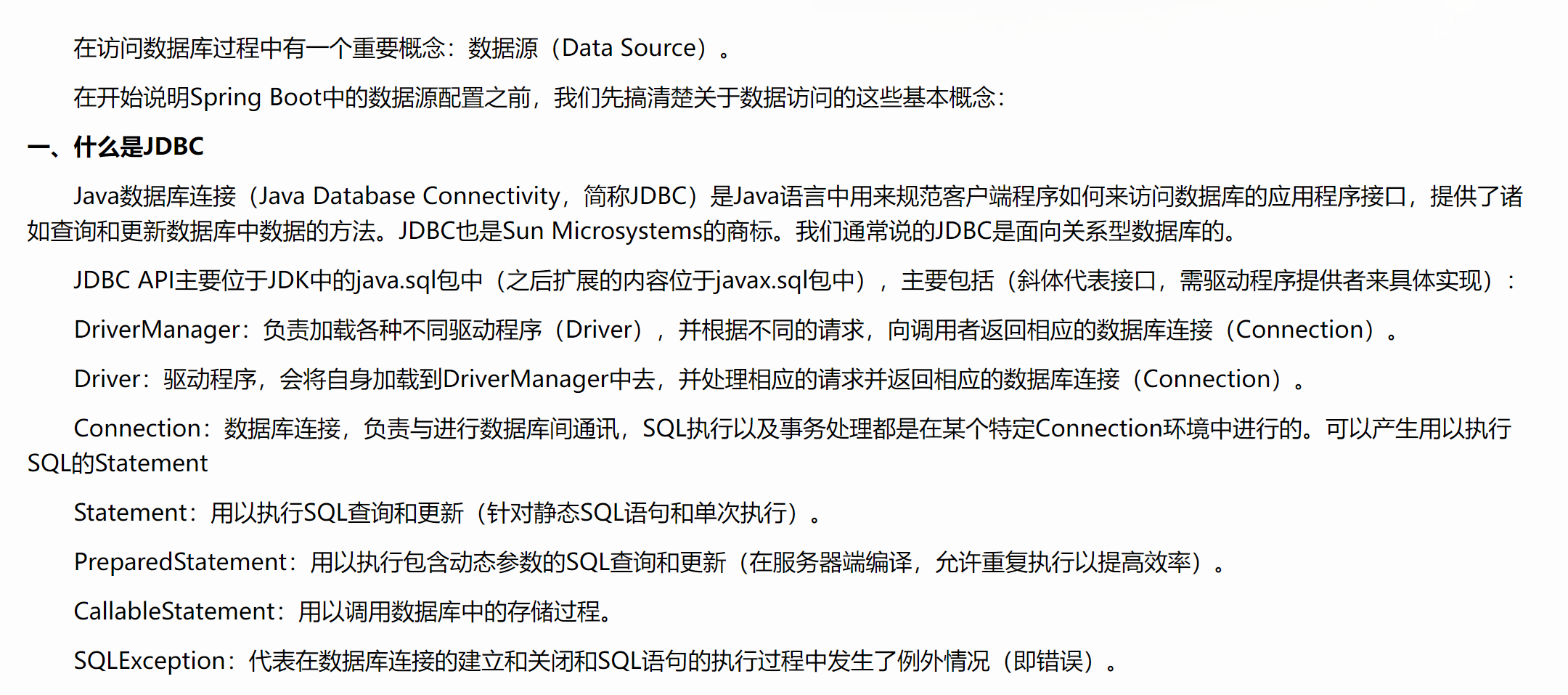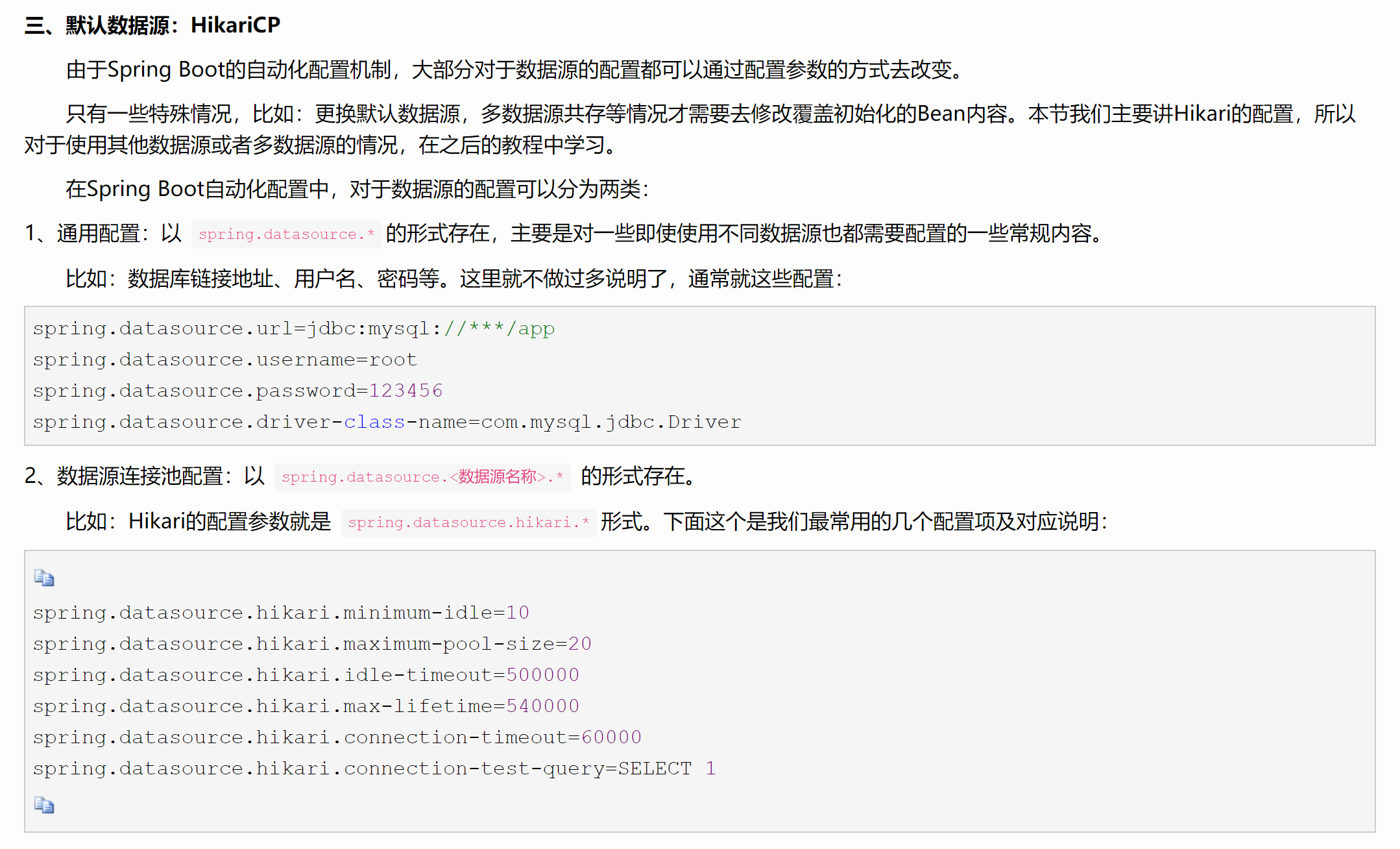整合JDBC+druid+MyBatis
1)jdbc
Sping Data 官网:https://spring.io/projects/spring-data
数据库相关的启动器 :可以参考官方文档:
https://docs.spring.io/spring-boot/docs/2.2.5.RELEASE/reference/htmlsingle/#using-boot-starter

application.yml:
spring:
datasource:
username: root
password: 123456
driver-class-name: com.mysql.cj.jdbc.Driver
url: jdbc:mysql://localhost:3306/mybatistest?useUnicode=true&characterEncoding=utf-8&useSSL=false&serverTimezone=GMT
配置完这些东西后,我们就可以直接去使用了,因为SpringBoot已经默认帮我们进行了自动配置
测试:
@RestController
public class HelloController {
@Autowired
JdbcTemplate jdbcTemplate;
@RequestMapping("/select")
public List<Map<String, Object>> select(){
String sql="select * from user";
List<Map<String, Object>> maps = jdbcTemplate.queryForList(sql);
return maps;
}
}
JDBCTemplate
-
即使不使用第三方第数据库操作框架,如 MyBatis等,Spring 本身也对原生的JDBC 做了轻量级的封装,即JdbcTemplate
-
数据库操作的所有 CRUD 方法都在 JdbcTemplate 中。
-
Spring Boot 不仅提供了默认的数据源,同时默认已经配置好了 JdbcTemplate 放在了容器中,程序员只需自己注入即可使用
-
JdbcTemplate 的自动配置是依赖 org.springframework.boot.autoconfigure.jdbc 包下的 JdbcTemplateConfiguration 类
JDBCTemplate主要提供以下几类方法:
-
execute方法:可以用于执行任何SQL语句,一般用于执行DDL语句;
-
update方法及batchUpdate方法:update方法用于执行新增、修改、删除等语句;batchUpdate方法用于执行批处理相关语句;
-
query方法及queryForXXX方法:用于执行查询相关语句;
-
call方法:用于执行存储过程、函数相关语句。
2)druid

<dependency>
<groupId>com.alibaba</groupId>
<artifactId>druid-spring-boot-starter</artifactId>
<version>1.1.21</version>
</dependency>

DruidConfig:
@Configuration
public class DruidConfig {
//将自定义的 Druid数据源添加到容器中,不再让 Spring Boot 自动创建
@ConfigurationProperties(prefix = "spring.datasource")
@Bean
public DataSource druidDataSource(){
return new DruidDataSource();
}
//后台监控,相当于web.xml
//因为springboot内置了servlet,没有web.xml,因此用ServletRegistrationBean来替代
@Bean
public ServletRegistrationBean statViewServlet(){
ServletRegistrationBean srb = new ServletRegistrationBean(new StatViewServlet(), "/druid/*");
//后台登录的账号密码
HashMap<String, String> initParameters = new HashMap<>();
//增加配置
initParameters.put("LoginUsername","admin");//这里的key是固定的
initParameters.put("LoginPassword","123456");
//允许谁可以访问
//initParameters.put("allow","");//默认允许所有都可以访问
srb.setInitParameters(initParameters);//设置初始化参数
return srb;
}
//过滤器
@Bean
public FilterRegistrationBean webStatFilter(){
FilterRegistrationBean frb = new FilterRegistrationBean();
frb.setFilter(new WebStatFilter());
//可以过滤的请求
HashMap<Object, Object> initParameters = new HashMap<>();
initParameters.put("exclusions","*.js,*.css,/druid/*");
frb.setInitParameters(initParameters);
return frb;
}
}
applcation.yml:
spring:
datasource:
username: root
password: 123456
driver-class-name: com.mysql.cj.jdbc.Driver
url: jdbc:mysql://localhost:3306/mybatistest?useUnicode=true&characterEncoding=utf-8&useSSL=false&serverTimezone=GMT
type: com.alibaba.druid.pool.DruidDataSource
#Spring Boot 默认是不注入这些属性值的,需要自己绑定
#druid 数据源专有配置
initialSize: 5
minIdle: 5
maxActive: 20
maxWait: 60000
timeBetweenEvictionRunsMillis: 60000
minEvictableIdleTimeMillis: 300000
validationQuery: SELECT 1 FROM DUAL
testWhileIdle: true
testOnBorrow: false
testOnReturn: false
poolPreparedStatements: true
#配置监控统计拦截的filters,stat:监控统计、log4j:日志记录、wall:防御sql注入
#如果允许时报错 java.lang.ClassNotFoundException: org.apache.log4j.Priority
#则导入 log4j 依赖即可,Maven 地址:https://mvnrepository.com/artifact/log4j/log4j
filters: stat,wall
maxPoolPreparedStatementPerConnectionSize: 20
useGlobalDataSourceStat: true
connectionProperties: druid.stat.mergeSql=true;druid.stat.slowSqlMillis=500
参考链接:https://mp.weixin.qq.com/s/wVAGOP1JdXZi5DMEsX1Aug
3)mybatis
1.mybatis整合包:
<dependency>
<groupId>org.mybatis.spring.boot</groupId>
<artifactId>mybatis-spring-boot-starter</artifactId>
<version>2.1.1</version>
</dependency>
2.配置数据库连接信息(同上不变)
3.编写代码

注意:这里为了测试,可以先不写service层,实际业务中需要写service层
UserMapper.xml:
<!DOCTYPE mapper
PUBLIC "-//mybatis.org//DTD Mapper 3.0//EN"
"http://mybatis.org/dtd/mybatis-3-mapper.dtd">
<mapper namespace="com.kakafa.springbootjdbc.mapper.UserMapper">
<select id="getUserList" resultType="user">
select * from mybatistest.user;
</select>
<select id="getUserById" parameterType="int" resultType="user">
select * from mybatistest.user where id = #{id};
</select>
<insert id="addUser" parameterType="user" >
insert into mybatistest.user(id,name,pwd) values(#{id},#{name},#{pwd});
</insert>
<update id="updateUser" parameterType="user">
update mybatistest.user
set name=#{name},pwd=#{pwd}
where id=#{id};
</update>
<delete id="deleteUser" parameterType="int">
delete
from mybatistest.user
where id=#{id};
</delete>
</mapper>
UserMapper:
@Mapper //是mybatis中的注解,表示将UserMapper交给Spring
@Repository //是springboot中的注解,表示这是一个dao层的类
//这个@Repository加不加都可以,因为@Mapper已经交给Spring容器管理了
public interface UserMapper {
//获取全部用户
List<User> getUserList();
//根据id查询用户
User getUserById(int id);
//插入一个用户
int addUser(User user);
//修改用户
int updateUser(User user);
//删除用户
int deleteUser(int id);
}
UserController:
@RestController
public class UserController {
@Autowired
private UserMapper userMapper;
@GetMapping("/queryUserList")
public List<User> queryUserList(){
List<User> userList = userMapper.getUserList();
return userList;
}
}
yml中要配置mybatis:

4.pom.xml中解决静态资源导出问题
<build>
<resources>
<resource>
<directory>src/main/java</directory>
<includes>
<include>**/*.properties</include>
<include>**/*.xml</include>
</includes>
<filtering>false</filtering>
</resource>
<resource>
<directory>src/main/resources</directory>
<includes>
<include>**/*.properties</include>
<include>**/*.xml</include>
</includes>
<filtering>false</filtering>
</resource>
</resources>
</build>

4)一些JDBC和数据源的解释



参考链接:https://www.cnblogs.com/goloving/p/14884802.html

 浙公网安备 33010602011771号
浙公网安备 33010602011771号